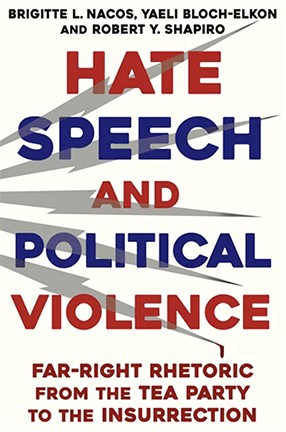Will History Repeat Itself With the 2024 Presidential Election?
A new book traces how the Tea Party laid the groundwork for the rise of Trump.

How did the U.S. descend into crisis, with institutions frayed, political violence mounting, and democracy in peril? Hate Speech and Political Violence: Far-Right Rhetoric From the Tea Party to the Insurrection identifies how the Tea Party and its extremist narratives laid the groundwork for the rise of Donald Trump, his Make America Great Again (MAGA) movement, and the January 6, 2021, assault on the U.S. Capitol.
Co-authors Robert Shapiro, the Wallace S. Sayre Professor of Government, and International and Public Affairs at Columbia SIPA, and Brigitte Nacos and Yaeli Bloch-Elkon, both research scholars at the Institute for Social and Economic Research Policy, trace the escalation of a strain of extremist rhetoric in right-wing political discourse after the inauguration of Barack Obama. Drawing on extensive, in-depth analysis of political communication in both traditional media and online spaces, they demonstrate how the dominant rhetorical styles of the Trump era were pioneered by the Tea Party. A backlash to the election of the first Black president, this reactionary social movement deployed violent language and spread anti-Obama paranoia, with the assistance of media insiders, GOP leaders, and conservative advocacy groups.
Trump rose to political prominence by hitching himself to the “birther” racist conspiracy theory, espoused by many Tea Partiers, and drew from their aggressive, hyper-partisan repertoire. Ultimately, as this book shows, the increasingly violent rhetoric of right-wing extremists spilled over into real-world political violence.
Columbia News recently caught up with co-author Brigitte Nacos to chat with her about the book, her thoughts on this year’s presidential election, and the process for working on a book written by three people.
How did this book come about?
Like all politically interested Americans, the three of us observed the establishment of the Tea Party in February 2009, just a few weeks after Obama’s presidential inauguration, and how it rapidly turned into a major political movement. Following the stunning success of the Tea Party-endorsed Republican congressional candidates in the 2010 midterm election, we wondered about the roles of mainstream media and online sites in the growth of the Tea Party. To study this, we began another joint research project, to follow our previous book, Selling Fear: Counterterrorism, the Media, and Public Opinion. As part of the research, we conducted systematic and quantitative content analyses of television networks and leading newspaper reports, examined the major Tea Party online sites, and analyzed relevant survey data from public opinion polls.
As we were concluding our Tea Party research and prepared to draft chapters, Trump announced his run for the presidency with a laundry list of grievances, and with promises that mirrored the Tea Party’s racist and nativist agenda. Ultimately, we decided to extend our research by examining the interconnectivity among the content of media communications (broadly defined) and public opinion, as well as the rise of Trump and, in particular, his spoken and written rhetoric. At the same time, we framed our research conceptually, emphasizing the interconnections of rhetoric and message conveyed by traditional media, new media, and the rise of social media.

Can you provide some examples from the book of how the Tea Party laid the groundwork for Trump, MAGA, and the Jan. 6, 2021, attack on the Capitol?
While secular libertarians who demanded tax cuts and lower government spending dominated the initial phase of the Tea Party, the religious, culture-war wing soon became dominant. This was reflected in the lively discussions on the Tea Party’s websites. Later, evangelical Christian Tea Partiers became part of Trump’s MAGA movement.
The aggressive language that these extreme Tea Partiers used in online posts foreshadowed the hostile and violent rhetoric of both candidate and President Trump. We found that Tea Party sites propagandized relentlessly the anti-Obama “birther” and “Obama-is-a-Muslim” conspiracy theories before Trump made himself the spokesperson-in-chief for both non-factual claims. In their online posts and comments, Tea Partiers attacked Obama, the Clintons, Liberals, Democrats, Socialists, Communists, and the mainstream media as existential threats to the America of “Patriots.” They did this several years before Trump magnified and amplified the same “we” against “them” divide in his speeches and social media tweets. Before the 2012 election, there were Tea Party voices online who called for stopping Obama “before it is too late.” The rhetoric’s violent overtones had implications for what followed later. Fast forward to 2021, after Trump’s election loss; his MAGA followers used violence in their effort to keep Trump in office.
As we examined the online site of the Oath Keepers, the military wing of the Tea Party, we found many threatening posts in which members attacked the U.S. government during the Obama years as “domestic enemies” who violated Americans’ constitutional rights and values. In their online pledges, individual Oath Keepers promised to defend their country. On January 6, 2021, when the U.S. Capitol was attacked, the Oath Keepers were among those para-military groups leading the charge.
Do you think history will repeat itself with this year's presidential election?
In Hate Speech and Political Violence, we end our concluding chapter, “Weaponized Words and Deeds Against Democracy,” with the warning that, based on our research, the violent events of January 6, 2021, might have been merely a rehearsal for a much greater threat to American liberal democracy.
Since then, Trump has sharpened his attack on everyone not completely loyal to him, and has left no doubt about his desire for a reign of retribution and power aggrandizement. He refuses to promise that he will respect the outcome of this year’s election, and signals that he will not accept defeat. Like in 2016 and 2020, Trump has gotten the greatest volume of news coverage at the expense of other GOP candidates and of President Biden. Not only has he regained his starring role on the FOX News network, but also in the mainstream media, including platforms tilting to the Left. While he still prefers his own Truth Social platform, he is allowed to post again on Twitter, now called X.
So, history has been repeating itself, and there may be more. It looks like Trump has learned from the past when his efforts at dictatorial power were thwarted by those around him, whom he appointed, as well as the opposition party. If he is elected president again, and the Republicans hold the House of Representatives and regain the Senate, he will indeed have new power to wield. If he loses in a close election—by a small number of votes in just a few states—we will see a replay of what happened from November 2020 into January 2021.
The top leaders of the Oath Keepers, Proud Boys, and several other militia groups are behind bars now. But if Trump would lose in November and call on his most extreme followers to fight for taking back their country, we would look for White Supremacists and neo-Nazis to follow his call.
What is it like to write a book with three authors? How does that work?
Since the three of us published our 2011 book, Selling Fear, we knew that we work very well together, so we decided to work again as a team on what started as our Tea Party project. While all three of us have taught and done research in the areas of mass media, public opinion, and politics/government, Bob and Yaeli have focused more on public opinion, and I have focused more on media. As one of us writes part of a chapter or research description, the other two provide comments, propose revisions, and edit. Because of the data and labor intensity of our research, we have engaged closely with our student research assistants at Columbia. We do not always immediately agree on everything we are doing, but we know how to discuss and resolve things to our mutual satisfaction. We are not only colleagues, but also friends.
By the time we finished the manuscript for this book, we had worked together for more than two decades on several articles and the two books. At this point, we have not—yet—discussed another project.